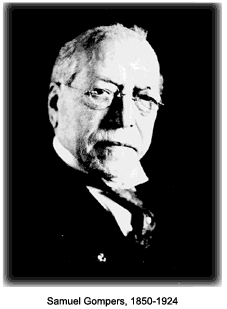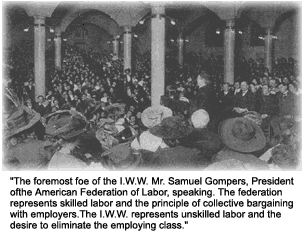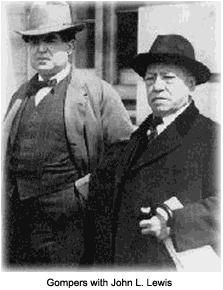Samuel Gompers was an early labor leader, first in his own union and later as president of the American Federation of Labor. As its president nearly continuously between 1886 and 1924, Gompers led the labor movement in achieving solid gains for workers. He maintained a focused view of trade unionism, believing that unions should concentrate on better collective bargaining agreements and legislation affecting labor, while avoiding broad social issues.
 Gompers was born in a London tenement on January 27, 1850, to poor immigrant Jews from Holland. His formal education ended at the age of 10, when he became an apprentice shoemaker. He soon switched to his father`s profession of cigar making. When the family moved to America in 1863, Gompers continued in the trade and became the first registered member of the Cigarmakers` International Union in 1864. In 1875, he was elected president of the union`s Local 144 in New York City.
Gompers was one of the organizers of the Federation of Organized Trades and Labor Unions of the United States and Canada in 1881. When it was reorganized in 1886 as the American Federation of Labor, he was elected its first president. He retained that position until his death in 1924 except for 1895, when he took a "sabbatical." The A.F. of L. grew from a mere 150,000 in 1886 to more than three million in 1924 at the time of his death.
The foremost national labor organization prior to the A.F. of L. was the Knights of Labor. That organization held a more inclusive view and offered membership to nearly everyone who worked: skilled or unskilled, manager or laborer. Gompers held a more restrictive organizational view. Due to the failure of the Missouri Pacific strike in 1886 and the disastrous Haymarket Square Riot of the same year, the Knights of Labor were seen in the public`s mind to have a radical agenda, including an eight-hour workday, during the 1880s. The appeal of Gompers` A.F. of L. to craft unions drew away most of the Knights` membership. By 1890, the A.F. of L. was clearly the preeminent national voice of labor, as Gompers led members to victories for shorter hours and higher wages.
Gompers was born in a London tenement on January 27, 1850, to poor immigrant Jews from Holland. His formal education ended at the age of 10, when he became an apprentice shoemaker. He soon switched to his father`s profession of cigar making. When the family moved to America in 1863, Gompers continued in the trade and became the first registered member of the Cigarmakers` International Union in 1864. In 1875, he was elected president of the union`s Local 144 in New York City.
Gompers was one of the organizers of the Federation of Organized Trades and Labor Unions of the United States and Canada in 1881. When it was reorganized in 1886 as the American Federation of Labor, he was elected its first president. He retained that position until his death in 1924 except for 1895, when he took a "sabbatical." The A.F. of L. grew from a mere 150,000 in 1886 to more than three million in 1924 at the time of his death.
The foremost national labor organization prior to the A.F. of L. was the Knights of Labor. That organization held a more inclusive view and offered membership to nearly everyone who worked: skilled or unskilled, manager or laborer. Gompers held a more restrictive organizational view. Due to the failure of the Missouri Pacific strike in 1886 and the disastrous Haymarket Square Riot of the same year, the Knights of Labor were seen in the public`s mind to have a radical agenda, including an eight-hour workday, during the 1880s. The appeal of Gompers` A.F. of L. to craft unions drew away most of the Knights` membership. By 1890, the A.F. of L. was clearly the preeminent national voice of labor, as Gompers led members to victories for shorter hours and higher wages.
 In politics, Gompers was conservative and distanced himself from socialist parties and such socialist labor movements as the Industrial Workers of the World, which believed that all workers should unite into a single union and that capitalism should be abolished. Members of that movement included Mother Jones and other popular labor activists during that time. Gompers accepted capitalism as the natural method of organizing production and made his goal the betterment of workers within the capitalist system.
He also considered craft unions, with membership drawn from workers doing similar tasks, to be the best framework to advance labor interests. This put him into conflict with the Knights of Labor, which organized workers on the basis of geographic area and included skilled and unskilled workers.
Later, he was opposed by advocates of industrial unions, and that eventually led to a rupture in the labor movement. Labor leader John L. Lewis organized the Committee for Industrial Organizations within the A.F. of L. in 1935 to include industrial unions. Lewis was highly successful in recruiting them, which caused irritation between the craft and industrial unions. The craft unions’ tendency to look down upon industrial workers as unskilled and untrained led to Lewis’ withdrawal from the A.F. of L. in 1938 to form the Congress of Industrial Organizations. The two organizations were apart until their merger in 1955 to form the AFL-CIO, the largest labor organization in the world.
In politics, Gompers was conservative and distanced himself from socialist parties and such socialist labor movements as the Industrial Workers of the World, which believed that all workers should unite into a single union and that capitalism should be abolished. Members of that movement included Mother Jones and other popular labor activists during that time. Gompers accepted capitalism as the natural method of organizing production and made his goal the betterment of workers within the capitalist system.
He also considered craft unions, with membership drawn from workers doing similar tasks, to be the best framework to advance labor interests. This put him into conflict with the Knights of Labor, which organized workers on the basis of geographic area and included skilled and unskilled workers.
Later, he was opposed by advocates of industrial unions, and that eventually led to a rupture in the labor movement. Labor leader John L. Lewis organized the Committee for Industrial Organizations within the A.F. of L. in 1935 to include industrial unions. Lewis was highly successful in recruiting them, which caused irritation between the craft and industrial unions. The craft unions’ tendency to look down upon industrial workers as unskilled and untrained led to Lewis’ withdrawal from the A.F. of L. in 1938 to form the Congress of Industrial Organizations. The two organizations were apart until their merger in 1955 to form the AFL-CIO, the largest labor organization in the world.
 Gompers was appointed by President Woodrow Wilson to the Advisory Committee of the Council of National Defense (1917 to 1919), on which he helped to establish an unprecedented wartime labor policy that clearly laid out government support for independent trade unions and collective bargaining. At the end of World War I, Wilson appointed Gompers to the Commission on International Labor Legislation at the Versailles Peace Conference, where he helped to create what became the International Labor Organization (ILO), under the League of Nations.
In 1919, Gompers requested that Calvin Coolidge, then governor of Massachusetts, dismiss the Boston police commissioner for having requested the use of state troops to break the Boston police strike. Coolidge replied that, "There is no right to strike against the public peace by anybody, anywhere, any time."
He also was president of the Pan-American Federation of Labor. Gompers was taken ill while attending a conference of that federation in Mexico City and died in San Antonio, Texas, on December 13, 1924. The U.S. Postal Service issued a stamp in 1950, commemorating the centenary of his birth.
Of the labor movement, Gompers said,
Gompers was appointed by President Woodrow Wilson to the Advisory Committee of the Council of National Defense (1917 to 1919), on which he helped to establish an unprecedented wartime labor policy that clearly laid out government support for independent trade unions and collective bargaining. At the end of World War I, Wilson appointed Gompers to the Commission on International Labor Legislation at the Versailles Peace Conference, where he helped to create what became the International Labor Organization (ILO), under the League of Nations.
In 1919, Gompers requested that Calvin Coolidge, then governor of Massachusetts, dismiss the Boston police commissioner for having requested the use of state troops to break the Boston police strike. Coolidge replied that, "There is no right to strike against the public peace by anybody, anywhere, any time."
He also was president of the Pan-American Federation of Labor. Gompers was taken ill while attending a conference of that federation in Mexico City and died in San Antonio, Texas, on December 13, 1924. The U.S. Postal Service issued a stamp in 1950, commemorating the centenary of his birth.
Of the labor movement, Gompers said,
“Our movement is of the working people, for the working people, by the working people,” he said. “There is not a right too long denied to which we do not aspire ... there is not a wrong too long endured that we are not determined to abolish.”